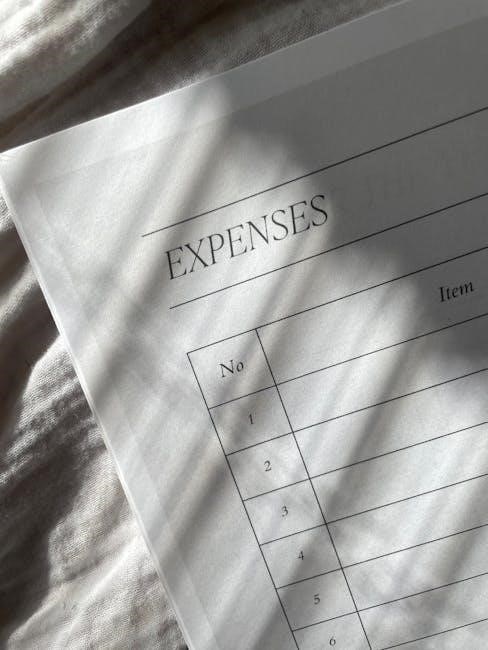
graphing functions worksheet pdf
Graphing functions involves plotting mathematical relationships on a coordinate plane‚ essential for visualizing their behavior and properties. Worksheets provide structured exercises for mastering this fundamental skill.
1.1 What Are Graphing Functions?
Graphing functions refers to the process of visually representing mathematical functions on a coordinate plane. It involves plotting points that satisfy the function’s equation‚ creating a graphical depiction of the relationship between variables. This method is essential for understanding the behavior‚ trends‚ and key features of functions‚ such as linearity‚ curvature‚ and intercepts. Worksheets on graphing functions often include exercises like identifying domains and ranges‚ evaluating functions‚ and creating tables of values. These tools help learners develop the ability to translate abstract equations into visual representations‚ making complex relationships more accessible and easier to analyze. By practicing with printable PDF worksheets‚ students can master the fundamentals of function graphing and build a strong foundation for advanced mathematical concepts.
1.2 Importance of Graphing Functions in Mathematics
Graphing functions holds significant importance in mathematics as it provides a visual representation of relationships between variables. This method aids in understanding the behavior of functions‚ such as identifying increasing or decreasing trends‚ intercepts‚ and turning points. It also helps in recognizing patterns‚ like linearity or curvature‚ which are crucial for analyzing real-world phenomena. Graphing is essential for solving problems in various fields‚ including science‚ engineering‚ and economics‚ where functional relationships are fundamental. Additionally‚ it enhances problem-solving skills and critical thinking by allowing learners to interpret and predict outcomes. Worksheets on graphing functions are widely used as educational tools to practice these concepts‚ ensuring a strong foundation for advanced mathematical studies and practical applications.

Key Concepts in Graphing Functions
Understanding functions‚ their properties‚ domain‚ range‚ notation‚ and evaluation is crucial. Identifying linear and nonlinear functions‚ along with their unique characteristics‚ forms the foundation of graphing skills.
2.1 Understanding Functions and Their Properties

Functions are relationships where each input (x-value) corresponds to exactly one output (y-value). Key properties include domain (possible x-values) and range (possible y-values). Worksheets help students identify these elements‚ ensuring a strong foundation for graphing. For instance‚ recognizing that functions must pass the vertical line test is crucial. Properties like evenness‚ oddness‚ and symmetry are also explored. Through exercises‚ students learn to evaluate functions at specific points‚ which aids in plotting graphs accurately. Printable worksheets often include tables for organizing values‚ making it easier to visualize and sketch functions. Mastering these properties is essential for advanced graphing techniques and real-world applications.
2.2 Domain and Range of Functions
The domain of a function is the set of all possible input values (x-values)‚ while the range is the set of all possible output values (y-values). Identifying these is crucial for graphing functions accurately. Worksheets often include exercises where students determine the domain and range from function definitions or graphs. For example‚ quadratic functions have a domain of all real numbers but a range dependent on the vertex. Linear functions typically have both domain and range as all real numbers unless restricted. Understanding these concepts helps in sketching accurate graphs and interpreting function behavior. Printable worksheets provide ample practice‚ ensuring students can identify and apply domain and range effectively in various mathematical scenarios.
2.3 Function Notation and Evaluation
Function notation is a way to represent relationships between variables‚ where outputs depend on inputs. For example‚ in f(x) = 2x + 3‚ f(x) represents the output for any given x. Evaluating functions involves substituting specific values into the function to find corresponding outputs. Worksheets often include exercises where students evaluate functions at particular points‚ creating tables of values to aid in graphing. This skill is essential for understanding how functions behave and for identifying key features like intercepts and rates of change. Practice with function notation and evaluation helps students master these concepts‚ enabling them to solve real-world problems and graph functions accurately.
2.4 Identifying Linear and Nonlinear Functions
Identifying whether a function is linear or nonlinear is crucial in graphing. Linear functions have a constant rate of change‚ resulting in straight-line graphs‚ while nonlinear functions exhibit varying rates of change‚ producing curves or irregular shapes. Worksheets often include exercises where students analyze functions to determine their linearity by calculating slopes between points or examining their algebraic forms. For example‚ functions like f(x) = 2x + 3 are linear‚ while f(x) = x² or f(x) = 3^x are nonlinear. Recognizing patterns in function notation and evaluating their behavior helps students classify them accurately. This skill is foundational for graphing and understanding the unique characteristics of each function type.

How to Graph Functions
Graphing functions involves a step-by-step process‚ including creating tables of values‚ plotting points‚ and identifying key features like intercepts and slopes.
3.1 Step-by-Step Guide to Graphing Functions
A step-by-step guide to graphing functions is essential for clarity. Begin by identifying the function type‚ then determine its domain and range. Next‚ calculate key points like intercepts and slopes. Create a table of values to plot points accurately on the coordinate plane. Analyze the function for symmetry and transformations. Finally‚ sketch the graph‚ ensuring smooth connections between plotted points. This methodical approach helps in understanding function behavior and identifying essential features. Worksheets provide structured exercises to practice these steps‚ reinforcing the process for students. Regular practice with such guides enhances graphing skills and conceptual understanding. By following these steps‚ learners can accurately graph functions and interpret their characteristics effectively.
3.2 Creating Tables of Values for Functions
Creating tables of values is a foundational step in graphing functions. By selecting input values (x) and calculating corresponding outputs (y)‚ students can systematically plot points. This method helps visualize function behavior‚ identify patterns‚ and pinpoint key features like intercepts and turning points. Tables are particularly useful for linear and quadratic functions‚ where consistent intervals ensure accuracy. They also aid in identifying symmetry and transformations. Printable worksheets often include tables for practice‚ allowing learners to fill in values and connect them to graph points. This structured approach reinforces understanding and prepares students for more complex graphing tasks. Regular practice with table creation strengthens the connection between algebraic functions and their graphical representations‚ making it easier to interpret and analyze functions effectively.
3.3 Plotting Points on a Coordinate Plane
Plotting points on a coordinate plane is a crucial skill for graphing functions. By translating table values into visual points‚ students can observe the function’s shape and behavior. Printable worksheets often include grids to help learners accurately plot points and connect them to form the function’s graph. This step is essential for understanding how inputs (x-values) correspond to outputs (y-values); Regular practice with plotting points enhances spatial reasoning and mathematical visualization skills. Worksheets also provide exercises for identifying key features like intercepts‚ slopes‚ and patterns‚ making them an invaluable tool for mastering function graphing. Free PDF resources offer a variety of exercises‚ ensuring comprehensive practice for learners at all levels.
3.4 Identifying Key Features of Function Graphs
Identifying key features of function graphs is essential for understanding their behavior. Worksheets often include exercises to locate intercepts‚ slopes‚ and turning points. For linear functions‚ identifying the y-intercept and slope is straightforward‚ while quadratic functions require finding the vertex and determining if the parabola opens upward or downward. Rational functions involve identifying vertical and horizontal asymptotes‚ and exponential functions focus on growth rates and asymptotic behavior. Practice worksheets help students recognize these features systematically‚ enhancing their ability to sketch and interpret graphs accurately. Free PDF resources provide diverse exercises‚ ensuring learners can identify and analyze these critical elements effectively‚ which is vital for advanced mathematical modeling and problem-solving. Regular practice reinforces these skills‚ building confidence in graphing various function types.

Types of Functions to Graph
Graphing functions includes linear‚ quadratic‚ polynomial‚ rational‚ exponential‚ and piecewise functions. Worksheets provide exercises for each type‚ focusing on their unique characteristics and plotting techniques.
4.1 Linear Functions and Their Graphs
Linear functions are fundamental in graphing‚ represented by equations of the form y = mx + b. Worksheets often include exercises where students plot these lines by identifying slope (m) and y-intercept (b). Graphing linear functions helps students understand the concept of constant rate of change‚ which is a key feature of these functions. By creating tables of values and plotting points‚ learners can visualize how changes in x lead to proportional changes in y. These exercises are essential for building foundational skills in graphing more complex functions later. Printable worksheets typically include multiple examples‚ allowing students to practice and reinforce their understanding of linear graphs.
4.2 Quadratic Functions and Parabolas
Quadratic functions are polynomial functions of degree two‚ represented by equations like ( y = ax^2 + bx + c ). Their graphs are parabolas‚ which can open upwards‚ downwards‚ or be wide or narrow. Worksheets often include exercises where students graph these functions by plotting points‚ completing tables‚ and identifying key features such as the vertex‚ focus‚ directrix‚ and axis of symmetry. Understanding how the coefficients ( a )‚ ( b )‚ and ( c ) affect the shape and position of the parabola is crucial. These exercises help learners visualize the relationship between quadratic equations and their parabolic graphs‚ making it easier to analyze and interpret real-world applications. Practice worksheets typically include multiple examples‚ allowing students to master graphing quadratic functions and identifying their properties.

4.3 Polynomial Functions of Higher Degree
Polynomial functions of higher degree‚ such as cubic (degree 3)‚ quartic (degree 4)‚ and quintic (degree 5) functions‚ exhibit more complex graphs compared to linear and quadratic functions. Their shapes can include multiple turns‚ local maxima‚ and minima‚ making them challenging but fascinating to graph. Worksheets often provide exercises where students plot points‚ create tables of values‚ and identify key features like end behavior‚ intercepts‚ and turning points. Understanding how the degree of the polynomial affects the graph’s complexity is essential. These exercises help learners develop skills in analyzing and sketching higher-degree polynomials‚ which are crucial for advanced mathematical studies and real-world applications in fields like engineering and physics. Practice worksheets typically include a variety of examples to ensure mastery of graphing techniques for higher-degree polynomials.

4.4 Rational Functions and Their Asymptotes
Rational functions are ratios of polynomial functions‚ often written as ( f(x) = rac{P(x)}{Q(x)} )‚ where ( P(x) ) and ( Q(x) ) are polynomials. Their graphs are characterized by asymptotes‚ which are lines that the graph approaches but never touches. Vertical asymptotes occur at the zeros of the denominator‚ while horizontal or oblique asymptotes depend on the degrees of the numerator and denominator. Graphing rational functions involves identifying these asymptotes‚ determining intercepts‚ and analyzing the behavior of the function as ( x ) approaches critical values. Worksheets provide exercises to practice plotting points‚ sketching graphs‚ and identifying key features like asymptotes and intervals of increase or decrease. Mastering these skills is crucial for understanding the behavior of rational functions and their real-world applications in fields like engineering and economics.
4.5 Exponential and Logarithmic Functions
Exponential and logarithmic functions are fundamental in mathematics‚ with applications in science‚ finance‚ and engineering. Exponential functions‚ such as ( y = ab^x )‚ grow or decay rapidly‚ depending on the base ( b ). Logarithmic functions‚ their inverses‚ are used to solve exponential equations and measure quantities like pH levels or sound intensity. Graphing these functions involves identifying key features like asymptotes‚ intercepts‚ and end behavior. Worksheets often include exercises to plot points‚ analyze growth rates‚ and solve real-world problems‚ such as population growth or radioactive decay. Mastering these functions is essential for understanding their practical applications and solving complex mathematical models.
4.6 Piecewise Functions and Their Graphs
Piecewise functions are defined by different expressions over specific intervals of the independent variable. Their graphs are constructed by plotting each segment separately‚ ensuring continuity or identifying breaks. For example‚ the absolute value function is a simple piecewise function with a V-shape graph. Worksheets often include exercises to define intervals‚ evaluate functions at boundary points‚ and identify points of discontinuity or sharp turns; Graphing piecewise functions helps visualize how different rules apply in various domains‚ making them essential for modeling real-world phenomena like tax brackets or multi-stage processes. Practice with these functions enhances problem-solving skills and prepares students for advanced mathematical modeling and analysis.

Real-World Applications of Graphing Functions
Graphing functions models real-world phenomena like population growth‚ financial trends‚ and physical motion‚ enabling precise predictions and analyses in science‚ engineering‚ and economics through visual representation.
5.1 Graphing Functions in Science and Engineering
In science and engineering‚ graphing functions is crucial for analyzing data and understanding relationships. For instance‚ plotting velocity against time helps determine acceleration‚ while graphing temperature changes over time aids in climate modeling. Engineers use function graphs to design systems‚ such as electronic circuits or structural load distributions. These visual representations simplify complex data‚ enabling precise predictions and informed decision-making. Worksheets on graphing functions provide essential practice for students‚ helping them master skills applicable to real-world problem-solving. By translating mathematical functions into graphical forms‚ scientists and engineers can identify patterns‚ test hypotheses‚ and optimize solutions effectively.
5.2 Economic Applications of Function Graphing
Graphing functions plays a vital role in economics for modeling and analyzing relationships between variables. For instance‚ economists use function graphs to illustrate supply and demand curves‚ understanding how price and quantity interact in a market. Plotting cost-benefit analyses helps businesses make informed decisions about production and pricing. Additionally‚ graphing functions like GDP growth over time enables economists to track economic health and predict future trends. Worksheets on graphing functions provide students with practical exercises to master these skills‚ essential for real-world economic problem-solving. By visualizing economic functions‚ professionals can identify patterns‚ optimize resources‚ and develop policies effectively.
5.3 Graphing Functions in Everyday Life
Graphing functions is a practical skill that extends beyond academia‚ influencing daily decisions and activities. For instance‚ creating a budget involves graphing income versus expenses to manage finances effectively. Fitness enthusiasts use function graphs to track progress‚ such as weight loss or exercise intensity over time. Planning events like weddings or parties often requires scheduling timelines‚ which can be visualized through function graphs. Even cooking involves understanding relationships between ingredients and cooking times‚ which can be represented graphically. Worksheets on graphing functions help individuals develop these skills‚ enabling them to visualize and analyze data in real-life scenarios. By mastering function graphing‚ people can make informed decisions‚ plan efficiently‚ and solve everyday problems more systematically.
5.4 Using Function Graphs to Model Real-World Phenomena
Function graphs are invaluable tools for modeling real-world phenomena‚ allowing us to visualize and analyze complex relationships. In science‚ functions can represent population growth‚ where the graph shows how a species’ number changes over time. In economics‚ function graphs depict supply-demand dynamics or market trends. Environmental studies use function graphs to illustrate climate patterns‚ such as temperature fluctuations or sea-level rise. These graphical representations enable researchers and professionals to identify trends‚ make predictions‚ and develop solutions. By translating data into visual form‚ function graphs simplify the understanding of intricate systems. Worksheets on graphing functions provide exercises that simulate these real-world applications‚ helping learners develop the skills to model and interpret phenomena effectively.

Tools and Resources for Graphing Functions
Printable PDF worksheets and digital tools like graphing calculators simplify the learning process. Online resources‚ such as graph paper templates and interactive software‚ enhance accuracy and engagement in plotting functions.
6.1 Printable Graphing Function Worksheets
Printable graphing function worksheets are essential tools for practicing and mastering the skill of plotting mathematical relationships. These worksheets‚ available in PDF format‚ offer a variety of exercises tailored for different skill levels. They cover key topics such as identifying functions‚ determining domain and range‚ creating function tables‚ and graphing linear and quadratic functions. Many worksheets include answer keys‚ providing students with immediate feedback and helping them track their progress. These resources are particularly useful for high school students and educators seeking structured practice materials. With exercises ranging from basic function identification to complex graph transformations‚ printable worksheets ensure comprehensive understanding and accuracy in graphing functions. They also serve as valuable supplements for classroom instruction or independent study‚ making them a go-to resource for learners of all levels.
6.2 Digital Tools for Graphing Functions
Digital tools have revolutionized the way students and educators approach graphing functions. Platforms like Desmos and GeoGebra offer interactive graphing capabilities‚ allowing users to visualize functions in real-time. These tools enable the exploration of linear‚ quadratic‚ and complex functions with ease. Features such as zooming‚ panning‚ and dynamic parameter adjustments make learning engaging. Additionally‚ Kuta Software provides digital worksheets and exercises for practice. Online graphing calculators and apps like Graphing Calculator+ are also popular for their portability and accessibility. These tools not only enhance understanding but also provide immediate feedback‚ making them invaluable for both classroom and independent learning. They cater to diverse learning styles and preferences‚ ensuring a comprehensive grasp of function graphing concepts.
6.3 Graph Paper and Grids for Accurate Plotting
Graph paper and grids are essential tools for accurate plotting of functions. They provide a structured framework with evenly spaced lines‚ helping students maintain scale consistency and proportion. Using graph paper ensures precise plotting of points‚ reducing errors in visual representation. Many worksheets include grid templates specifically designed for graphing functions‚ offering pre-printed axes and intervals. These resources are particularly useful for beginners‚ as they simplify the process of identifying key features like intercepts‚ vertices‚ and asymptotes. Additionally‚ free downloadable graph paper templates are widely available online‚ catering to various educational needs. By utilizing these tools‚ learners can focus on understanding the mathematical relationships rather than the mechanics of drawing axes and grids manually. This enhances both the accuracy and efficiency of graphing functions.
6.4 Online Resources for Practice and Learning
Online resources provide a wealth of opportunities to practice and learn graphing functions. Websites like Math-Aids.com and Kuta Software offer free‚ downloadable worksheets in PDF format‚ covering topics like domain and range‚ function evaluation‚ and graphing linear and quadratic functions. These resources are ideal for students and educators seeking structured exercises. Additionally‚ platforms such as Desmos provide interactive graphing tools‚ allowing users to visualize functions dynamically. Many online resources also include video tutorials‚ step-by-step guides‚ and interactive simulations to enhance understanding. These tools are particularly useful for self-paced learning and classroom instruction‚ ensuring access to high-quality materials for mastering graphing functions. They cater to diverse learning styles‚ making the process engaging and effective for all skill levels. Regular practice with these resources fosters proficiency in graphing functions and related mathematical concepts.

Best Practices for Learning and Teaching Graphing Functions
Consistent practice with function worksheets‚ using interactive graphing tools‚ and providing detailed feedback are key strategies. These methods enhance understanding and build confidence in graphing functions effectively.
7.1 Tips for Students to Master Graphing Functions
Mastering graphing functions requires consistent practice and a systematic approach. Start by understanding the basics of functions‚ such as domain‚ range‚ and function notation. Use printable worksheets to practice identifying and evaluating functions. Create tables of values to plot points accurately on a coordinate plane. Begin with linear functions and gradually progress to quadratic and higher-degree polynomials. Regularly review and correct mistakes to build confidence. Utilize digital graphing tools to visualize function behavior and explore transformations. Collaborate with peers or tutors to discuss challenging problems. Finally‚ dedicate time to real-world applications to appreciate the practical relevance of graphing functions. Regular practice and review are essential for long-term mastery.
7.2 Strategies for Educators to Teach Function Graphing
Educators can effectively teach function graphing by incorporating structured lessons and hands-on activities. Begin with the basics‚ such as understanding function notation and properties‚ before introducing graphing techniques. Use printable worksheets to provide students with practice exercises‚ focusing on plotting points‚ identifying domains and ranges‚ and recognizing function types. Integrate digital tools to enhance visualization and engagement. Encourage collaborative learning through group activities and peer discussions. Provide immediate feedback on worksheets to help students correct mistakes. Incorporate real-world examples to illustrate the practical relevance of graphing functions. Offer differentiated instruction to cater to varying skill levels‚ ensuring all students can progress at their own pace. Regularly review and reinforce concepts to build a strong foundation for advanced topics.
7.3 Common Mistakes to Avoid When Graphing Functions
When graphing functions‚ students often make errors that can hinder their understanding. One common mistake is misidentifying functions‚ such as assuming all relations are functions. Ensure each input maps to only one output. Another error is incorrectly plotting points or miscalculating function values‚ leading to inaccurate graphs. Students may also overlook key features like intercepts‚ asymptotes‚ or vertices‚ which are crucial for understanding the function’s behavior. Additionally‚ neglecting to label axes or identify the domain and range can lead to confusion. Encourage attention to detail and regular practice to minimize these mistakes. Using worksheets with answer keys can help students identify and correct errors‚ improving their graphing skills over time.
7.4 The Importance of Regular Practice and Review
Regular practice and review are essential for mastering the skill of graphing functions. Consistent practice helps reinforce concepts‚ such as identifying functions‚ plotting points‚ and understanding domain and range. It also improves accuracy and speed when completing worksheets or solving problems. Reviewing previously learned material ensures retention and builds a strong foundation for more complex topics. Using graphing functions worksheet PDFs provides structured exercises to practice specific skills‚ such as evaluating functions‚ creating tables of values‚ and identifying key features of graphs. Regular practice helps students recognize and correct common mistakes‚ fostering confidence and proficiency. Over time‚ this consistent effort leads to a deeper understanding of mathematical relationships and their visual representations.


Leave a Reply
You must be logged in to post a comment.